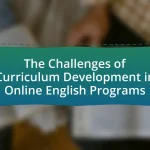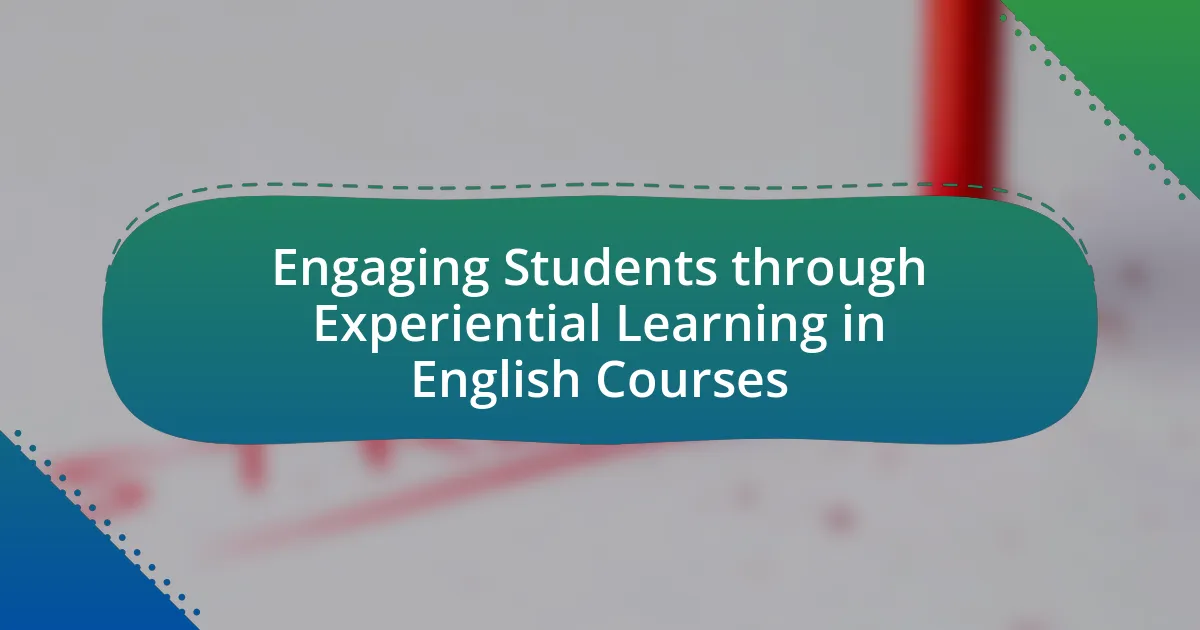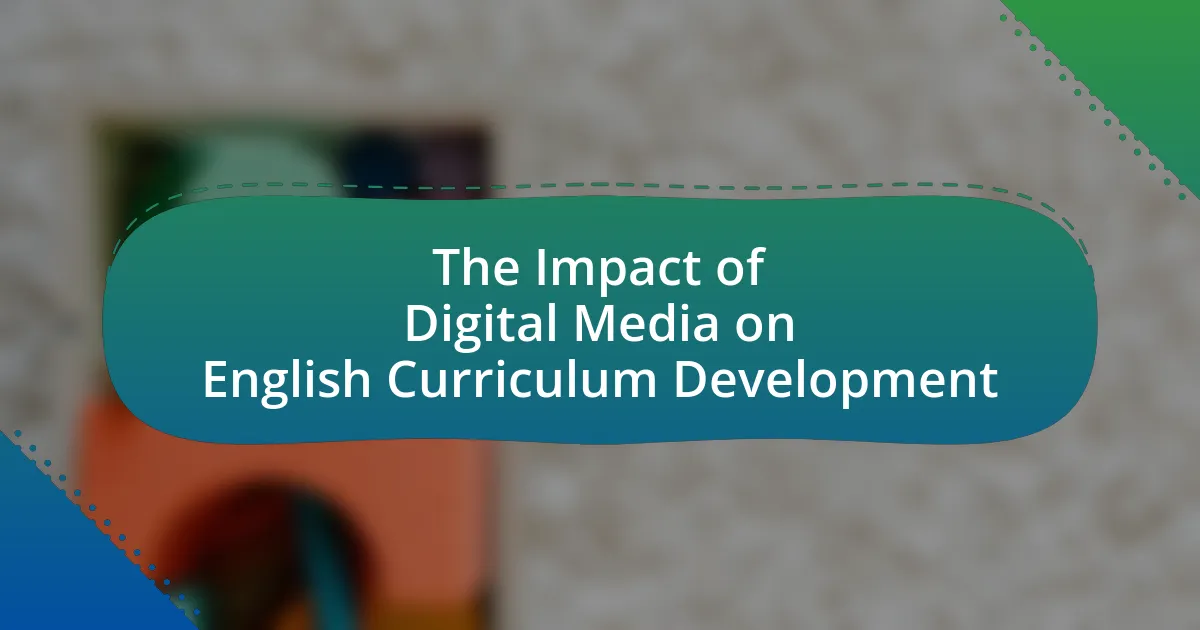The article focuses on the future of English curriculum development, highlighting current trends such as digital literacy, culturally responsive teaching, and integrated language skills. It examines the impact of technological advancements on English education, including the use of digital tools and online learning platforms that enhance student engagement. Additionally, the article discusses the importance of multiculturalism in the curriculum, the emphasis on critical thinking, and the evolving assessment practices that prioritize formative assessments. Predictions for the future include a greater focus on personalized learning, the integration of artificial intelligence, and the development of essential skills such as communication and creativity in English studies.

What are the current trends in English curriculum development?
Current trends in English curriculum development emphasize digital literacy, culturally responsive teaching, and integrated language skills. Digital literacy is increasingly prioritized as students engage with technology for reading, writing, and communication, reflecting the demands of modern society. Culturally responsive teaching is gaining traction, aiming to make the curriculum relevant to diverse student backgrounds and experiences, thereby enhancing engagement and learning outcomes. Additionally, integrated language skills focus on combining reading, writing, speaking, and listening in a cohesive manner, promoting a more holistic approach to language acquisition. These trends are supported by educational research indicating that such approaches lead to improved student performance and engagement in English language learning.
How are technological advancements influencing English curriculum?
Technological advancements are significantly influencing the English curriculum by integrating digital tools and resources that enhance learning experiences. These advancements facilitate interactive learning through platforms such as online writing labs, digital storytelling applications, and collaborative tools like Google Docs, which promote real-time feedback and peer review. Research indicates that the use of technology in education can improve student engagement and writing skills; for instance, a study by the Pew Research Center found that 87% of teachers believe that technology positively impacts student learning. Additionally, the incorporation of multimedia resources, such as videos and podcasts, caters to diverse learning styles, making literature and language studies more accessible and engaging for students.
What digital tools are being integrated into English teaching?
Digital tools being integrated into English teaching include learning management systems, interactive whiteboards, and language learning apps. Learning management systems like Google Classroom facilitate assignment distribution and feedback, while interactive whiteboards enhance engagement through multimedia presentations. Language learning apps such as Duolingo and Babbel provide personalized practice and gamified learning experiences. These tools have been shown to improve student engagement and learning outcomes, as evidenced by studies indicating that technology integration in classrooms can lead to higher academic performance and increased motivation among students.
How does online learning impact student engagement in English?
Online learning significantly enhances student engagement in English by providing interactive and flexible learning environments. Research indicates that online platforms facilitate active participation through multimedia resources, discussion forums, and real-time feedback, which cater to diverse learning styles. A study by the Online Learning Consortium found that students in online courses reported higher levels of engagement compared to traditional classroom settings, with 70% of participants indicating they felt more involved in their learning process. This increased engagement is attributed to the accessibility of resources and the ability to collaborate with peers globally, fostering a more dynamic and inclusive educational experience.
What role does multiculturalism play in modern English curricula?
Multiculturalism plays a crucial role in modern English curricula by promoting inclusivity and diverse perspectives in literature and language studies. This approach enriches students’ understanding of different cultures, fostering empathy and critical thinking. Research indicates that incorporating multicultural texts enhances students’ engagement and academic performance, as seen in studies like “The Impact of Multicultural Literature on Student Engagement” by Lee and Johnson, which found that students exposed to diverse narratives showed improved analytical skills and cultural awareness. Thus, multiculturalism not only reflects societal diversity but also prepares students for a globalized world.
How are diverse literary voices being included in the curriculum?
Diverse literary voices are being included in the curriculum through the integration of multicultural texts and authors from various backgrounds. Educational institutions are increasingly adopting literature that reflects a wide range of experiences, perspectives, and cultures, thereby promoting inclusivity. For instance, the National Council of Teachers of English emphasizes the importance of diverse literature in fostering empathy and understanding among students. Additionally, studies show that incorporating works by authors such as Chimamanda Ngozi Adichie and Junot Díaz not only enriches the curriculum but also engages students more effectively by connecting with their varied identities and experiences.
What benefits does multicultural education provide in English studies?
Multicultural education in English studies enhances cultural awareness and promotes inclusivity among students. By integrating diverse perspectives and texts from various cultures, students develop critical thinking skills and a deeper understanding of global issues. Research indicates that exposure to multicultural content improves empathy and communication skills, as students learn to appreciate different viewpoints. Furthermore, studies show that multicultural education can lead to higher academic engagement and motivation, as students see their own identities reflected in the curriculum.
How is the focus on critical thinking shaping English education?
The focus on critical thinking is shaping English education by promoting analytical skills and encouraging students to engage deeply with texts. This shift emphasizes the importance of evaluating arguments, understanding diverse perspectives, and developing coherent reasoning. Research indicates that curricula incorporating critical thinking lead to improved student outcomes, as evidenced by studies showing that students who engage in critical analysis perform better in reading comprehension and writing assessments. For instance, a report by the Partnership for 21st Century Skills highlights that critical thinking skills are essential for success in modern workplaces, reinforcing the need for their integration into English education.
What strategies are being implemented to enhance critical analysis skills?
Strategies being implemented to enhance critical analysis skills include the integration of inquiry-based learning, collaborative projects, and the use of technology in the classroom. Inquiry-based learning encourages students to ask questions and explore topics deeply, fostering critical thinking. Collaborative projects allow students to engage with diverse perspectives, enhancing their analytical abilities through discussion and debate. Additionally, technology tools, such as digital platforms for research and analysis, provide students with access to a wealth of information, enabling them to evaluate sources critically. These strategies are supported by educational research indicating that active engagement and collaboration significantly improve critical analysis skills among students.
How does critical thinking influence student outcomes in English?
Critical thinking significantly enhances student outcomes in English by fostering deeper comprehension and analytical skills. When students engage in critical thinking, they are better equipped to analyze texts, evaluate arguments, and construct coherent responses. Research indicates that students who practice critical thinking in English classes demonstrate improved writing skills, as they learn to articulate their thoughts clearly and support them with evidence. For instance, a study published in the Journal of Educational Psychology found that students who participated in critical thinking exercises scored 20% higher on writing assessments compared to those who did not. This correlation underscores the importance of integrating critical thinking into the English curriculum to promote effective communication and analytical abilities.

What predictions can be made about the future of English curriculum?
The future of the English curriculum is likely to emphasize digital literacy, critical thinking, and multicultural perspectives. As technology continues to evolve, curricula will increasingly integrate digital tools and resources, preparing students for a world where online communication is paramount. Research indicates that 85% of jobs in the future will require digital skills, highlighting the necessity for educational institutions to adapt. Additionally, the focus on critical thinking will enhance students’ abilities to analyze and evaluate information, a skill essential in an era of misinformation. Furthermore, incorporating multicultural perspectives will foster inclusivity and global awareness, reflecting the diverse society in which students live. These trends are supported by educational frameworks advocating for a more holistic and relevant approach to language education.
How will artificial intelligence impact English teaching methods?
Artificial intelligence will significantly enhance English teaching methods by personalizing learning experiences and providing real-time feedback. AI-driven tools can analyze individual student performance, adapting lessons to meet specific needs, which has been shown to improve engagement and retention rates. For instance, platforms like Grammarly and Duolingo utilize AI algorithms to tailor exercises based on user proficiency, resulting in more effective language acquisition. Additionally, AI can facilitate immersive learning environments through virtual reality and chatbots, allowing students to practice conversational skills in realistic scenarios. This integration of technology not only streamlines the teaching process but also prepares students for a digitally-driven world.
What potential applications of AI could enhance learning experiences?
AI can enhance learning experiences through personalized learning, intelligent tutoring systems, and automated assessment tools. Personalized learning utilizes AI algorithms to adapt educational content to individual student needs, improving engagement and retention. Intelligent tutoring systems provide real-time feedback and support, allowing students to learn at their own pace, which has been shown to increase mastery of subjects. Automated assessment tools streamline grading processes, enabling educators to focus more on teaching rather than administrative tasks, thus enhancing the overall learning environment. These applications are supported by studies indicating that personalized learning can lead to a 30% increase in student performance, while intelligent tutoring systems have been found to improve learning outcomes by 50% in some cases.
How might AI change the role of teachers in English classrooms?
AI may change the role of teachers in English classrooms by shifting their focus from traditional instruction to facilitating personalized learning experiences. With AI tools capable of analyzing student performance and tailoring content to individual needs, teachers can spend more time on mentorship and support rather than direct instruction. For instance, AI-driven platforms can provide real-time feedback on writing, allowing teachers to concentrate on developing critical thinking and communication skills in students. This transition is supported by research indicating that personalized learning can enhance student engagement and achievement, as seen in studies conducted by the Bill & Melinda Gates Foundation, which highlight the effectiveness of adaptive learning technologies in improving educational outcomes.
What shifts in assessment practices are expected in English education?
Shifts in assessment practices expected in English education include a move towards formative assessments that emphasize ongoing feedback and student self-assessment. This transition is driven by the need to foster critical thinking and adaptability in students, aligning with contemporary educational goals. Research indicates that formative assessments can significantly enhance student learning outcomes, as they provide opportunities for reflection and improvement, rather than solely focusing on summative evaluations. For instance, studies show that schools implementing formative assessment strategies report higher student engagement and achievement levels, highlighting the effectiveness of this approach in modern English education.
How will formative assessments evolve in the English curriculum?
Formative assessments in the English curriculum will evolve by integrating technology and personalized learning approaches. As educational technology advances, tools such as digital portfolios, online quizzes, and real-time feedback systems will become more prevalent, allowing for immediate assessment and tailored instruction. Research indicates that formative assessments that utilize technology can enhance student engagement and improve learning outcomes, as seen in studies like “The Impact of Formative Assessment on Student Learning” by Black and Wiliam, which highlights the effectiveness of timely feedback in promoting academic achievement. Additionally, the shift towards competency-based education will encourage formative assessments to focus on individual student progress, fostering a more personalized learning experience that addresses diverse learning needs.
What new metrics will be used to evaluate student performance?
New metrics to evaluate student performance will include personalized learning assessments, competency-based evaluations, and social-emotional learning indicators. Personalized learning assessments focus on individual student progress and mastery of specific skills rather than traditional grading systems. Competency-based evaluations measure students’ abilities to apply knowledge in real-world scenarios, emphasizing practical application over rote memorization. Social-emotional learning indicators assess students’ emotional intelligence, resilience, and interpersonal skills, recognizing their importance in overall academic success. These metrics reflect a shift towards a more holistic understanding of student performance, aligning with contemporary educational goals.
What future skills will be emphasized in English curricula?
Future skills emphasized in English curricula will include digital literacy, critical thinking, and intercultural communication. Digital literacy is essential as technology integration in education continues to grow, requiring students to navigate and analyze digital content effectively. Critical thinking will be prioritized to enable students to evaluate information critically and make informed decisions in an increasingly complex world. Intercultural communication skills will be highlighted to prepare students for global interactions, fostering understanding and collaboration across diverse cultures. These skills align with educational trends that focus on preparing students for a rapidly changing job market and global society.
How will communication skills be prioritized in future English classes?
Communication skills will be prioritized in future English classes through an increased focus on interactive learning methods and real-world applications. Educators will implement collaborative projects, discussions, and presentations to enhance students’ verbal and non-verbal communication abilities. Research indicates that active engagement in learning environments significantly improves communication proficiency, as seen in studies conducted by the National Communication Association, which highlight the effectiveness of experiential learning in developing essential communication skills.
What role will creativity play in the evolving English curriculum?
Creativity will play a central role in the evolving English curriculum by fostering critical thinking and enhancing student engagement. As educational frameworks shift towards more student-centered approaches, creativity encourages learners to express themselves and explore diverse perspectives through writing, literature, and communication. Research indicates that integrating creative practices in education leads to improved problem-solving skills and greater academic achievement, as evidenced by studies showing that students who engage in creative tasks demonstrate higher levels of motivation and retention of knowledge. Thus, the incorporation of creativity in the English curriculum is essential for developing well-rounded, innovative thinkers prepared for the complexities of the modern world.

How can educators adapt to these trends and predictions?
Educators can adapt to trends and predictions in the English curriculum by integrating technology, emphasizing critical thinking, and personalizing learning experiences. The integration of technology, such as digital platforms and online resources, allows educators to enhance engagement and accessibility, aligning with the increasing reliance on digital literacy in modern education. Emphasizing critical thinking skills prepares students for complex problem-solving and analysis, which are essential in a rapidly changing world. Personalizing learning experiences caters to diverse student needs and learning styles, fostering a more inclusive environment. Research indicates that personalized learning can lead to improved student outcomes, as highlighted in the study “Personalized Learning: A Guide for Engaging Students with Technology” by the International Society for Technology in Education.
What strategies can teachers employ to integrate technology effectively?
Teachers can integrate technology effectively by utilizing blended learning models, which combine traditional face-to-face instruction with online learning components. This approach allows for personalized learning experiences, enabling students to progress at their own pace while accessing a variety of digital resources. Research from the U.S. Department of Education indicates that blended learning can lead to improved student outcomes, as it fosters engagement and accommodates diverse learning styles. Additionally, teachers can implement tools such as interactive whiteboards, educational apps, and online collaboration platforms to enhance classroom interaction and facilitate real-time feedback. These strategies not only promote digital literacy but also prepare students for a technology-driven future.
How can educators select appropriate digital tools for their classrooms?
Educators can select appropriate digital tools for their classrooms by assessing their specific educational goals, understanding the needs of their students, and evaluating the functionality and usability of the tools. This process involves identifying the learning outcomes they aim to achieve, such as enhancing engagement or improving literacy skills, and then researching tools that align with these objectives. For instance, a study by the International Society for Technology in Education (ISTE) emphasizes the importance of aligning technology with pedagogical strategies to maximize effectiveness. Additionally, educators should consider user reviews and case studies to gauge the effectiveness of tools in similar educational settings, ensuring that the selected tools are not only relevant but also user-friendly for both teachers and students.
What training is necessary for teachers to utilize technology in English?
Teachers require training in digital literacy, pedagogical strategies for technology integration, and specific software tools to effectively utilize technology in English instruction. This training should encompass understanding how to use educational technology platforms, such as learning management systems and interactive tools, to enhance student engagement and learning outcomes. Research indicates that teachers who receive targeted professional development in these areas are more likely to implement technology effectively in their classrooms, leading to improved student performance and engagement in English language learning.
How can teachers foster a multicultural environment in their classrooms?
Teachers can foster a multicultural environment in their classrooms by integrating diverse cultural perspectives into the curriculum. This can be achieved by selecting literature, resources, and materials that represent various cultures, thereby promoting inclusivity and understanding among students. Research indicates that classrooms incorporating multicultural education can enhance students’ cultural awareness and empathy, leading to improved social interactions and academic performance. For instance, a study by Banks and Banks (2010) highlights that multicultural education not only enriches the learning experience but also prepares students for a diverse society.
What resources are available for incorporating diverse literature?
Resources available for incorporating diverse literature include curated book lists, educational organizations, and online databases. Curated book lists, such as those provided by the American Library Association, highlight diverse authors and themes, ensuring educators have access to a wide range of perspectives. Educational organizations like We Need Diverse Books offer resources, including teaching guides and author interviews, to support the integration of diverse literature into curricula. Additionally, online databases such as TeachingBooks.net provide multimedia resources and author information that enhance the teaching of diverse texts. These resources collectively facilitate the incorporation of diverse literature into English curricula, promoting inclusivity and representation in education.
How can teachers promote inclusivity in English discussions?
Teachers can promote inclusivity in English discussions by implementing diverse teaching strategies that accommodate various learning styles and backgrounds. For instance, incorporating texts from a wide range of cultures and perspectives allows all students to see themselves represented in the curriculum, fostering a sense of belonging. Research indicates that inclusive practices, such as collaborative group work and differentiated instruction, enhance student engagement and participation, leading to improved academic outcomes. A study by the National Education Association found that classrooms that embrace inclusivity see a 20% increase in student participation rates, demonstrating the effectiveness of these approaches in creating an equitable learning environment.
What best practices should educators follow to enhance critical thinking?
Educators should implement inquiry-based learning to enhance critical thinking. This approach encourages students to ask questions, investigate, and engage in problem-solving, fostering deeper understanding and analytical skills. Research by the National Education Association indicates that inquiry-based learning significantly improves students’ critical thinking abilities, as it promotes active engagement and collaboration among peers. Additionally, integrating real-world problems into the curriculum allows students to apply their critical thinking skills in practical contexts, further reinforcing their learning and understanding.
How can collaborative learning be used to develop critical skills?
Collaborative learning can be used to develop critical skills by fostering teamwork, communication, and problem-solving abilities among learners. This approach encourages students to engage with diverse perspectives, enhancing their analytical thinking and adaptability. Research indicates that collaborative learning environments lead to improved critical thinking skills, as students must articulate their ideas, challenge assumptions, and negotiate solutions collectively. For instance, a study by Johnson and Johnson (1999) found that cooperative learning strategies significantly enhance higher-order thinking skills compared to traditional learning methods.
What role does feedback play in fostering critical thinking in students?
Feedback plays a crucial role in fostering critical thinking in students by providing them with specific insights into their thought processes and reasoning. This targeted feedback encourages students to reflect on their ideas, analyze their arguments, and consider alternative perspectives, which are essential components of critical thinking. Research indicates that formative feedback, which is timely and constructive, significantly enhances students’ ability to evaluate their own work and engage in deeper cognitive processes. For instance, a study published in the “Journal of Educational Psychology” by Hattie and Timperley (2007) found that effective feedback can lead to improved learning outcomes by guiding students to think critically about their performance and make necessary adjustments.




